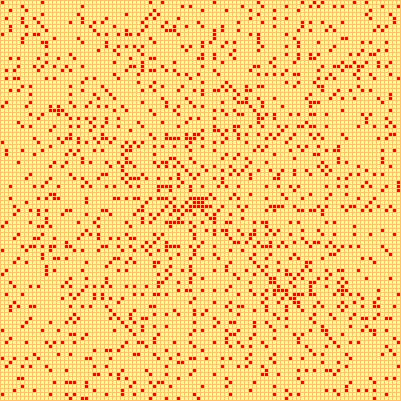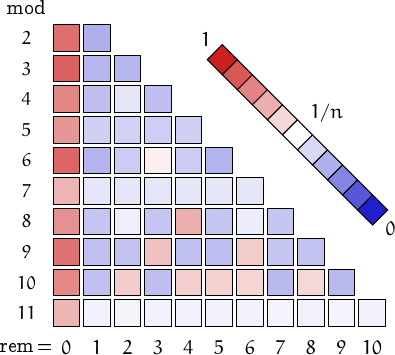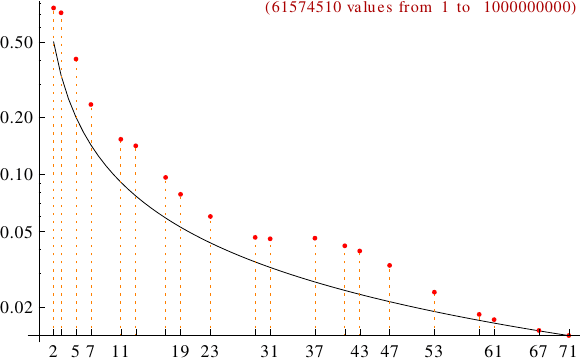A number  is a Harshad (also called Niven) number
if it is divisible by the sum of its digits.
is a Harshad (also called Niven) number
if it is divisible by the sum of its digits.

For example, 666 is divisible by 6+6+6 so it is a Harshad number.
C.Cooper & R.E.Kennedy proved that it is possible to have at most 20 consecutive Niven numbers and this happens infinitely often.
| L | Starts of runs of length L |
|---|---|
| 2 | 20, 80, 132, 152, 200, 209, 224, 399, 407, 440 |
| 3 | 110, 1010, 2464, 4912, 5054, 5831, 7360, 8203 |
| 4 | 510, 1014, 2022, 3030, 10307, 12102, 12255 |
| 5 | 131052, 491424, 1275140, 1310412, 1474224 |
| 6 | 12751220, 14250624, 22314620, 22604423 |
| 7 | 10000095, 41441420, 207207020, 233735070 |
| 8 | 2162049150, 10810245630, 18039122682 |
| 9 | 124324220, 621621020, 1243242020 |
| 10 | 1, 602102100620, 1002301700420 |
| 11 | 920067411130599 |
| 12 | 43494229746440272890 |
| 13 | 12100324200007455010742303399999999999999999990 |
Below, the spiral pattern of Harshad numbers up to . See the page on prime numbers for an explanation and links to similar pictures.
The first Harshad numbers are 1, 2, 3, 4, 5, 6, 7, 8, 9, 10, 12, 18, 20, 21, 24, 27, 30, 36, 40, 42, 45, 48, 50, 54, 60, 63, 70, 72, 80, 81, 84, 90 more terms
Pictorial representation of remainders (mod 2, 3, ...,11) frequency. For a table of values and more details click here

A graph displaying how many Harshad numbers are multiples of the primes p from 2 to 71. In black the ideal line 1/p.

Harshad numbers can also be... (you may click on names or numbers and on + to get more values)
ABA
18
24
50
+
9996980000
aban
10
12
18
+
10000000000
abundant
12
18
20
+
50000000
Achilles
72
108
200
+
9999898832
admirable
12
20
24
+
99894896
alt.fact.
5784634181
alternating
10
12
18
+
989898909
amenable
12
20
21
+
1000000000
amicable
220
2620
2924
+
9844469775
anti-perfect
285
apocalyptic
192
220
222
+
30000
arithmetic
20
21
27
+
9999990
astonishing
27
204
216
+
4278092598
automorphic
12890625
787109376
Bell
4140
betrothed
48
140
195
+
9629379500
binomial
10
20
21
+
9999171820
brilliant
10
21
209
+
1679
c.decagonal
3781
20801
50501
+
9715011601
c.heptagonal
736
19426
36058
+
9998597533
c.nonagonal
10
190
820
+
9999171820
c.octagonal
81
225
441
+
9995000625
c.pentagonal
2176
2976
9456
+
9996821151
c.square
481
20605
26221
+
9968014013
c.triangular
10
460
2584
+
9973768960
cake
42
378
576
+
9886503251
Carmichael
1729
2465
2821
+
9456330241
Catalan
42
132
58786
+
6564120420
compositorial
24
192
1728
+
696729600
congruent
20
21
24
+
9999990
constructible
10
12
20
+
8589803520
cube
27
216
512
+
9910665792
Cullen
20971521
Cunningham
10
24
48
+
9998200080
Curzon
18
21
30
+
199999605
cyclic
133
209
247
+
9999881
D-number
21
63
111
+
6727539
d-powerful
24
63
132
+
9998252
de Polignac
2465
4311
6021
+
99996401
decagonal
10
27
126
+
9997050217
deceptive
481
1729
2821
+
9768280201
deficient
10
21
27
+
9999950
dig.balanced
10
12
21
+
199999936
double fact.
48
3840
46080
+
3715891200
droll
72
240
800
+
9767485440
Duffinian
21
27
36
+
9999881
eban
30
36
40
+
6066066060
economical
10
21
27
+
20000000
emirpimes
511
629
1011
+
99992171
enlightened
2176
2304
23328
+
2377970784
equidigital
10
21
27
+
19999709
eRAP
20
24
1104
+
9998143700
esthetic
10
12
21
+
9898987876
Eulerian
120
247
47840
+
3464764515
evil
10
12
18
+
999999926
factorial
24
120
720
+
6227020800
fibodiv
9744
13010
23418
+
9441619425
Fibonacci
21
144
2584
14930352
Friedman
126
153
216
+
995364
frugal
243
512
1215
+
999968571
gapful
100
108
110
+
10000000000
Gilda
110
152
220
+
9410385642
Giuga
30
happy
10
70
100
+
10000000
harmonic
140
270
1638
+
9866368512
heptagonal
18
81
112
+
9998149140
hex
1141
1387
3781
+
9936180151
hexagonal
45
120
153
+
9999171820
highly composite
12
24
36
+
6983776800
hoax
84
234
308
+
99996350
Hogben
21
111
133
+
9988303423
house
13959
15962
32103
+
9991438059
hungry
144
hyperperfect
21
2133
176661
+
8589869056
iban
10
12
20
+
777770
iccanobiF
1053
idoneal
10
12
18
+
1848
impolite
512
inconsummate
63
84
195
+
999852
insolite
111
11112
111111111
+
1211162112
interprime
12
18
21
+
99999965
Jacobsthal
21
171
1365
1398101
Jordan-Polya
12
24
36
+
9953280000
junction
111
117
204
+
99999966
Kaprekar
45
999
2223
+
8888888889
katadrome
10
20
21
+
9876543210
Lehmer
133
247
481
+
9996982621
Leyland
54
100
320
+
2179768320
lonely
120
1341
1344
+
47326801
Lucas
18
322
5778
lucky
21
63
111
+
9999825
Lynch-Bell
12
24
36
+
9867312
magic
111
870
2465
+
9885306184
magnanimous
12
20
21
+
62202281
metadrome
12
18
24
+
12345679
modest
111
133
209
+
1999826829
Moran
18
21
27
+
99999965
Motzkin
21
113634
310572
narcissistic
153
370
407
+
472335975
nialpdrome
10
20
21
+
10000000000
nonagonal
24
111
204
+
9997902714
nude
12
24
36
+
499999968
O'Halloran
12
20
36
+
660
oban
10
12
18
+
999
octagonal
21
40
133
+
9996757776
odious
21
42
50
+
1000000000
palindromic
111
171
222
+
8998558998
pancake
407
704
2212
+
9991254121
panconsummate
10
12
18
+
3097
pandigital
21
108
114
+
9876543210
partition
30
42
135
+
4835271870
pentagonal
12
70
117
+
9999553032
perfect
8589869056
pernicious
10
12
18
+
9999950
Perrin
10
12
90
+
5209407
persistent
1067283945
1067284395
1067284935
+
9876543210
plaindrome
12
18
24
+
8888888889
Poulet
645
1387
1729
+
9640119601
power
27
36
81
+
10000000000
powerful
27
36
72
+
10000000000
practical
12
18
20
+
10000000
prim.abundant
12
18
20
+
99967959
primeval
10279
12345679
1012345678
primorial
30
210
2310
+
223092870
pronic
12
20
30
+
9999900000
Proth
81
209
225
+
9999613953
pseudoperfect
12
18
20
+
1000000
repdigit
111
222
333
+
999999999
repfigit
1104
2208
2580
298320
repunit
21
40
63
+
9988303423
Rhonda
4752
5439
5832
+
9821117252
Ruth-Aaron
24
50
126
+
9999280186
Saint-Exupery
60
480
780
+
9999974400
Sastry
715
13224
647238399
+
1568473680
self
20
42
108
+
999999926
self-describing
10313316
10333116
12153331
+
8822888888
semiprime
10
21
111
+
99993563
sliding
20
70
110
+
9250000000
Smith
27
378
576
+
99999050
sphenic
30
42
70
+
99999965
square
36
81
100
+
10000000000
star
35113
80041
143221
+
9992002033
straight-line
111
135
210
+
9876543210
strobogrammatic
111
888
8118
+
9901691066
subfactorial
1854
1334961
super Niven
10
12
20
+
10000000000
super-d
81
190
247
+
9999881
superabundant
12
24
36
+
6983776800
tau
12
18
24
+
1000000000
taxicab
1729
4104
32832
+
9978655232
tetrahedral
10
20
84
+
9993352005
tetranacci
108
147312
triangular
10
21
36
+
9999171820
tribonacci
24
81
504
+
53798080
trimorphic
24
375
624
+
999999999
uban
10
12
18
+
10000000000
Ulam
18
36
48
+
10000236
undulating
171
252
414
+
9090909090
unprimeable
200
204
320
+
10000000
untouchable
120
162
210
+
999990
upside-down
555
53575
58525
+
599951115
vampire
1260
1530
102510
+
9953948970
wasteful
12
18
20
+
9999990
weird
70
10792
11410
+
994490
Wieferich
22953
298389
2685501
+
3626459235
Woodall
63
80
4607
+
3486784400
Zeisel
1729
5069629
185245273
+
1017436249
Zuckerman
12
24
36
+
9991111212
Zumkeller
12
20
24
+
100000
zygodrome
111
222
333
+
9999999666